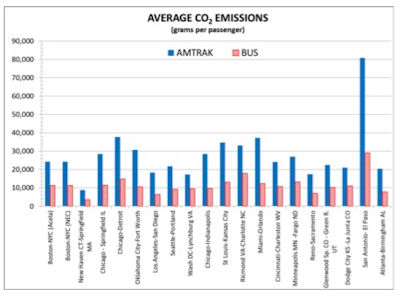Translate
Friday, August 2, 2013
Analysis Show The Fiscal Benefits of Buses
Deron Lovaas Posted August 1, 2013
As I’ve written (here, here and here, for starters) it’s high time buses received more attention and investment in this country. Everyone loves to talk about other modes – especially bikes and trains – as the sine qua non for energy-efficient, livable and sustainable communities.
Meanwhile, year in and year out, ridership on buses eclipses other non-auto modes. They are oft-maligned workhorses of the transportation system. Thankfully, within cities there’s a sizzling new entry in the bus marketplace – bus rapid transit. As friends noted a few years ago in a report, these lines are cropping up across the country as signs of transit innovation. Launched originally in Curitiba, Brazil decades ago by a visionary mayor (don’t cities usually lead the way?), this means of bus travel is spreading around the world as well as across the U.S. In fact, there’s even an effort afoot to standardize and grade “bus rapid transit” projects to make sure they live up to the name so the brand won’t get tarnished over time. Now is the time to turn our attention to bus routes between cities.
Right now more than 16,000 buses ply our roads, connecting nearly 2,800 cities and towns. This week friends at Taxpayers for Common Sense, the Reason Foundation and the American Bus Association Foundation released an analysis by respected consulting firm MJ Bradley and Associates, comparing bus to Amtrak service linking 20 city pairs. One of the performance metrics examined is air pollution, and buses shine here (although, to be clear, both modes shine when compared to driving alone).
The graph below illustrates this for heat-trapping carbon dioxide pollution: Busgraph1.jpg While this may seem surprising considering the bad rap buses get vis-à-vis tailpipe emissions, it makes sense when you think about it. First of all, trains pollute too, although you (like me) probably suffer from “availability bias,” meaning that images readily spring to mind of being stuck in traffic behind a bus annoyingly spewing pollution while none of us gets trapped behind a train. But buses are getting cleaner, and trains aren’t pollution-free (the analysts note that the electrified Northeast Corridor is cleanest). And more importantly, these vehicles are only as clean on a per-passenger basis as their load factor determines.
A fully loaded vehicle looks good compared to an emptier one, per-passenger, as you can see from this graph from a report I co-wrote a few years ago (pdf of whole report here):
What about costs?
Again, buses compare well. First the analysts examined fares charged, finding that while they vary they are usually comparable on these routes. However, the cost differential between them is huge, as you can see from the graph below. Busgraph2.jpg How is the gap filled? If you guessed government subsidies, you are right.
The graph below shows just how large they are, with two exceptions: The Boston-NYC and Washington, DC-Lynchburg, VA stretches of eastern corridor service. These latter routes actually make enough revenue to more than pay for themselves. The analysts note that a few other routes pay for their operating costs, but fall short when capital costs are included. Busgraph3.jpg To wrap this glimpse of this study up,
I want to make clear that I am not saying we should rob Peter to pay Paul. We need more, and upgraded, rail service connecting our cities. However, we also need real competition if consumers are to benefit (this is the whole point of a little coalition we formed with the American Bus Association, among others, called Mobility Choice).
Consumers deserve multiple options for traveling between cities. That means that we need more, and upgraded bus service as well. I used to travel regularly on C & J buses in the northeast and can testify that it can be cost-effective and comfortable already, so there's a solid foundation for expansion and improvement. But all too often buses get a bad rap, and not enough attention in national, state and metropolitan policy. That needs to change, given the data presented in this report, and in the wake of the BRT revolution underway.
Let’s get to work on delivering more rubber-tired transit service linking cities, by giving buses a seat at the table when making transportation investment plans and programs.
Subscribe to:
Post Comments (Atom)






No comments:
Post a Comment